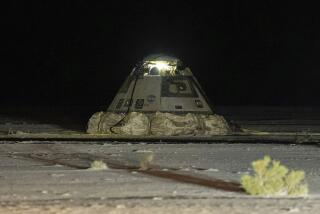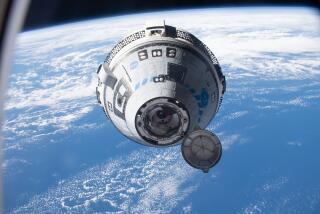Although Safer, Space Shuttle Is Still a Risky Ride
- Share via
When the National Aeronautics and Space Administration first sent the space shuttle into orbit in April 1981, the agency assured the American public that the vehicle was as safe as a Boeing 747 jetliner.
The space agency’s misplaced confidence would later be considered a contributing cause in the Challenger accident and would compound the public loss of confidence in the agency.
NASA managers today acknowledge that another shuttle disaster is a realistic possibility but they say improvements since Challenger have made the system safer and have given astronauts a chance of surviving an explosion like the one that killed the seven in 1986.
“This is a high-risk operation,” acknowledged Bryan O’Connor, NASA’s director of space shuttle operations. “The public understands this now a lot better than before Challenger.”
Before Challenger, NASA estimated the probability of a shuttle loss at just 1 in 10,000, O’Connor said. Immediately after the Challenger loss, a study by the Science Applications International Corp. for NASA put the probability of an accident at 1 in 78 flights. The high probability meant that NASA would be due for another accident in the next several years.
NASA asked the company to update the study last year, taking into account all the improvements made to the boosters and the orbiter. Science Applications concluded that the probability of another catastrophic accident is now one in 248 flights, O’Connor said. Further improvements should continue to reduce the risk through the rest of the decade, he added.
But aerospace experts say that the design of the shuttle will always make it an inherently high-risk vehicle. A single failure of any of several hundred crucial parts on the shuttle can cause a catastrophic loss, said Joe Sutter, the former design chief at Boeing who served on the Challenger commission. By contrast, a commercial jetliner has redundant systems to back up virtually every single part on an aircraft, Sutter said.
“The shuttle is the most dangerous vehicle flying today,” Sutter added. “But I can’t fault NASA for the way they are doing business now. It is a safer vehicle now than at the time of the accident. It isn’t foolproof though.”
In the aftermath of the Challenger explosion, experts debated whether the astronauts might have survived the accident. Every indication is that the astronauts survived the explosion and died during the 2 1/2-minute fall to the ocean.
O’Connor, a former astronaut, said the seven crew members of the Challenger might have survived if they had been equipped with emergency oxygen bottles, parachutes and a hatch that could be opened from the inside. Shuttles now carry that equipment.
“If those measures were available on Challenger, some of the crew would have survived,” he said. “If we lose a shuttle but the crew survives, the public would feel a lot different about it.”
NASA is preparing to turn over more of its shuttle operations to a team of private contractors, who would sharply cut costs. Experts are questioning whether safety might suffer, but former Challenger commission members and NASA officials insist that a bloated work force did not guarantee Challenger’s safety in 1986 and that future cutbacks in staff will not necessarily jeopardize future safety.
More to Read
Sign up for Essential California
The most important California stories and recommendations in your inbox every morning.
You may occasionally receive promotional content from the Los Angeles Times.











